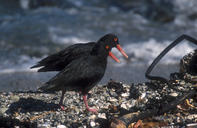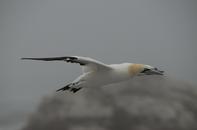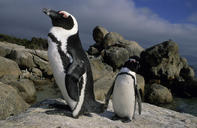Common and Uncommon Birds

In the ecologically delicate region where land and sea adjoin, man's presence has made itself strongly felt. Whereas the grey headed gull, Larus cirrocephalus, benefits by feeding on scraps and the offal of gutted fish, the black oystercatcher, Haematopus moquini, is highly sensitive to intrusions, by offroad vehicles for example, into Its beach breeding sites.
Oystercatchers are common within localized areas, but number only about 5 000 birds along South Africa's entire coast.
Cape cormorants, Phalacrocorax capensis, occur from the Cunene River mouth to southern Mozambique, but are abundant only along South Africa's west coast. They can be seen at dawn and dusk, flying in long, undulating lines along the near-shore. Cape cormorants settle on the water in large flocks to feed, and nest on offshore islands.
Nutrient Rich Guano

A bird of considerable economic importance is the Cape gannet, Morus capensis, whose nutrient-rich guano is regularly collected from its six offshore breeding islands for use in the manufacture of agricultural fertilizer. Flocks of gannets often feed in association with tunny and other gamefish.
The most common albatross off the Cape coast, the black browed albatross, Diomedea melanophris, is a pelagic seabird and winter migrant, likely to be seen only by deep-sea fishermen and sailors. These birds may gather in flocks of over a thousand to squabble over the fish discarded by trawlers.
Coastal Breeders

Of the 75 bird species recorded around the coast of southern Africa, only 14 are known to breed there, including the African penguin, Spheniscus demersus, who’s old common name was a jackass penguin, named for its braying call. Because they spend much of their time at sea, penguins are particularly susceptible to commercial overfishing and to the scourge of oil pollution.
If one includes rare stragglers, fully 20 different varieties of tern have been recorded along our coastline in summer. The Caspian Tern, Hydroprogne caspia, is the easiest to identify, being by far the largest of its sub-family.